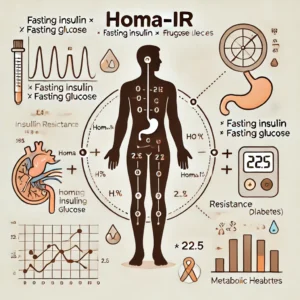The human body functions through a series of intricate and delicate processes, each playing a vital role in maintaining overall health. Among these, insulin, a crucial hormone, helps regulate blood glucose levels. However, when the body’s cells fail to respond to insulin properly, a condition called insulin resistance develops. This problem significantly increases the risk of type 2 diabetes, cardiovascular diseases, and metabolic syndrome.
To diagnose and address this issue effectively, HOMA-IR (Homeostatic Model Assessment for Insulin Resistance) emerges as a critical tool. It is a measurement model that evaluates the interaction between insulin and glucose to determine the level of insulin resistance.
In this article, we will delve into the details of HOMA-IR, how it works, its practical significance, and strategies for reducing insulin resistance.
The History and Background of HOMA-IR
HOMA-IR was first developed in 1985 when medical researchers were seeking a simple yet effective way to measure insulin resistance. Since then, it has played an integral role in diabetes research. The primary appeal of this method lies in its simplicity. Using fasting insulin and glucose levels, it provides an accurate calculation of insulin resistance.
The popularity of HOMA-IR has grown because it is a cost-effective and straightforward method for evaluating the risk of diabetes and metabolic diseases. While advanced methods like the clamp test or OGTT (Oral Glucose Tolerance Test) exist, they are time-consuming and expensive compared to HOMA-IR.
How Does HOMA-IR Work?
To calculate HOMA-IR, fasting blood samples are collected. This is because fasting insulin and glucose levels provide a clear picture of the body’s metabolic state.
The following formula is used to calculate HOMA-IR:
HOMA-IR = (Fasting Insulin × Fasting Glucose) ÷ 22.5
Fasting insulin refers to the level of insulin in the blood while fasting, and fasting glucose refers to the blood sugar level during the same period.
For example, if a person’s fasting insulin is 15 μU/mL and fasting glucose is 6 mmol/L, their HOMA-IR value would be:
(15 × 6) ÷ 22.5 = 4. This value indicates a high level of insulin resistance, signaling an increased risk of metabolic disorders.
Ideal HOMA-IR Levels and Their Importance
The ideal HOMA-IR value can vary based on age, gender, and other individual factors. However, a general guideline suggests that a value below 1 is considered normal. Values between 1 and 2.5 indicate the possibility of insulin resistance, while values above 2.5 are considered high risk, indicating a significant chance of developing diabetes, cardiovascular diseases, and metabolic syndrome.
Causes and Effects of Insulin Resistance
Insulin resistance is often directly linked to lifestyle and dietary habits. A diet high in sugar and processed foods is a primary contributor. Excess sugar forces the body to produce more insulin, but over time, the cells stop responding effectively, reducing insulin sensitivity.
Physical inactivity is another major factor. Individuals who do not engage in regular physical activity are more prone to insulin resistance. Additionally, stress increases cortisol levels in the body, which negatively affects insulin sensitivity.
HOMA-IR and Diabetes
HOMA-IR is closely associated with diabetes, particularly type 2 diabetes. When the body’s cells lose sensitivity to insulin, it fails to regulate blood sugar effectively. Over time, this condition develops into diabetes. By detecting insulin resistance early, HOMA-IR serves as a valuable tool for preventing diabetes.
Strategies to Lower HOMA-IR
Reducing HOMA-IR requires significant changes in diet and lifestyle. First, adopting a diet rich in natural, unprocessed foods is essential. Cutting down on sugar and refined carbohydrates improves the body’s insulin efficiency. Consuming high-protein and fiber-rich foods slows glucose absorption, aiding in lowering HOMA-IR.
Regular physical activity is another crucial approach to reducing HOMA-IR. Engaging in at least 30 minutes of exercise daily, such as walking, jogging, or yoga, improves insulin sensitivity. Stress management techniques, like meditation and mindfulness, also play a vital role.
Role of Specific Foods in Enhancing Insulin Sensitivity
Certain foods have been proven to enhance insulin sensitivity. For instance, cinnamon helps regulate blood glucose levels. Apple cider vinegar reduces glucose absorption after meals. Foods rich in omega-3 fatty acids, such as fish, nuts, and olive oil, are effective in combating insulin resistance.
Global Research on HOMA-IR
Studies across different regions reveal variations in HOMA-IR values. Developing nations often have higher HOMA-IR values compared to developed countries, which can be attributed to differences in dietary habits and lifestyle. Recent research highlights how urbanization and modern living are contributing to rising HOMA-IR values globally.
Consulting a Physician for HOMA-IR Assessment
It is essential to consult a physician to determine your HOMA-IR value. Regular testing is recommended for individuals with a family history of diabetes or abnormal body weight. Based on HOMA-IR results, healthcare professionals can provide tailored dietary and lifestyle recommendations to reduce the risk of metabolic diseases.
Conclusion
HOMA-IR is not just a number; it provides critical insights into the body’s metabolic health. It plays a key role in identifying the risk of diabetes and other metabolic disorders. Timely testing and lifestyle modifications can help mitigate these risks.
The connection between physical and mental health is profound. Taking the right steps not only ensures physical well-being but also enhances mental clarity. Awareness and planning are crucial for leading a healthy and fulfilling life.
By taking control of your diet, exercise, and stress management, you can significantly improve your HOMA-IR levels and reduce your risk of chronic diseases. If you suspect insulin resistance or are at risk of diabetes, consult a healthcare professional to guide you on the path to better health.
